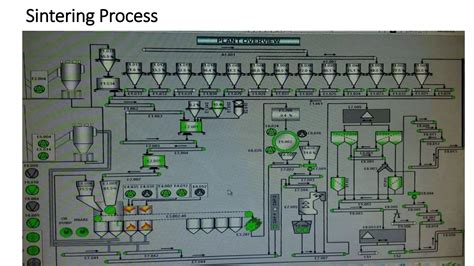Sintering: The Art of Bonding Solids
Introduction
Sintering is a captivating materials processing technique that allows us to transform loose particles into a cohesive solid body. It entails heating the particles below their melting points, allowing them to form new bonds and consolidate into a dense, porous structure.
The Importance of Sintering Techniques
Sintering plays a critical role in various industries, including ceramics, metallurgy, and electronics. It enables the production of high-performance materials with tailored properties, such as increased strength, durability, and thermal conductivity.
Types of Sintering

-
Solid-state sintering: Bonding occurs through atomic diffusion without melting.
-
Liquid-phase sintering: A liquid phase forms between the particles, aiding in densification.
-
Reaction sintering: Sintering involves chemical reactions between the particles.
Factors Influencing Sintering
-
Temperature: Higher temperatures accelerate diffusion and bonding.
-
Dwell time: Prolonged heating allows for stronger bonds to form.
-
Particle size: Smaller particles provide more surface area for bonding.
-
Atmosphere: The presence of certain gases can enhance or inhibit sintering.
-
Pressure: Applied pressure helps bring particles closer together.
Strategies for Effective Sintering
-
Optimizing temperature and dwell time: Use data from sintering curves to determine ideal parameters.
-
Controlling particle size and distribution: Ensure uniform particle size to avoid defects.
-
Manipulating the atmosphere: Introduce inert gases to prevent oxidation or create reducing atmospheres for metal sintering.
-
Applying pressure: Cold isostatic pressing (CIP) or hot pressing techniques can enhance density.
Common Errors in Sintering and How to Avoid Them
-
Insufficient heating: Ensure proper temperature and dwell time to achieve adequate bonding.
-
Agglomeration: Prevent particle clumping by optimizing dispersion techniques.
-
Warpage: Use supports or control heating rates to minimize distortions.
-
Cracking: Sintering under high temperatures or stresses can lead to cracks; adjust process parameters accordingly.
A Step-by-Step Guide to Sintering
- Prepare the powder by mixing, milling, and pressing into a desired shape.
- Select appropriate sintering parameters based on material properties.
- Sinter the component in a controlled atmosphere furnace.
- Cool the sintered part slowly to avoid stresses.
Possible Disadvantages of Sintering

-
Porosity: Sintered materials often contain some porosity, which can affect properties.
-
Shrinkage: Sintering can cause significant shrinkage, which must be considered in design.
-
Cost: Sintering can be a time-consuming and energy-intensive process.
Interesting Stories and Lessons Learned from Sintering
Story 1:

- A ceramic engineer was tasked with sintering a batch of high-strength ceramic tiles.
- She accidentally used a higher temperature than recommended, resulting in excessive shrinkage and cracking.
-
Lesson: Adhere strictly to sintering parameters to avoid defects.
Story 2:
- A metallurgist was trying to create a lightweight metal part by sintering metal powder.
- He used a reducing atmosphere, which resulted in the formation of a brittle phase in the sintered material.
-
Lesson: Control the atmosphere to prevent the formation of unwanted phases.
Story 3:
- A research team was experimenting with a novel sintering technique to produce porous materials.
- They applied excessive pressure during sintering, causing the particles to flatten and reducing porosity.
-
Lesson: Optimize pressure to achieve desired porosity.
Frequently Asked Questions about Sintering
- What is the difference between solid-state and liquid-phase sintering?
- How does temperature affect sintering?
- What are the advantages of using pressure during sintering?
- Can you sinter different materials together?
- Why is cooling rate important in sintering?
- What are the applications of sintered materials?
Tables
Table 1: Sintering Curves for Different Materials
| Material |
Sintering Temperature (°C) |
Dwell Time (h) |
| Alumina |
1650 |
2-4 |
| Zirconia |
1450 |
6-8 |
| Iron |
1250 |
10-12 |
Table 2: Advantages and Disadvantages of Sintering Techniques
| Technique |
Advantages |
Disadvantages |
| Solid-state sintering |
No liquid phase required, high strength |
Slow process, can produce defects |
| Liquid-phase sintering |
Enhanced densification, faster process |
Can form unwanted phases, weaker bonds |
| Reaction sintering |
Unique properties, reduces porosity |
Can be more complex and expensive |
Table 3: Applications of Sintered Materials
| Application |
Material |
Properties |
| Ceramics |
Alumina, Zirconia |
High strength, thermal conductivity, wear resistance |
| Metals |
Iron, Steel |
Enhanced mechanical properties, porosity control |
| Electronics |
Copper, Silver |
Electrical conductivity, thermal dissipation |
Conclusion
Sintering is a versatile technique that enables the creation of advanced materials with tailored properties. By understanding the principles of sintering and employing effective strategies, manufacturers can optimize the process to achieve high-quality components. This technology continues to revolutionize industries and open new avenues for innovation in material science.

References

